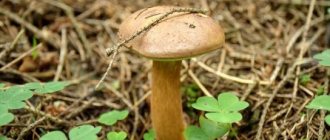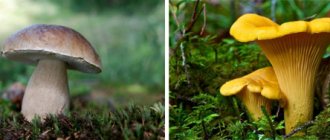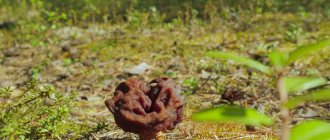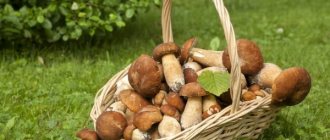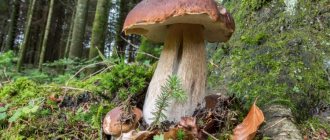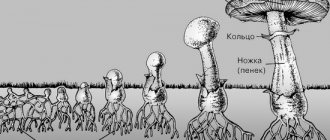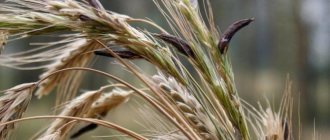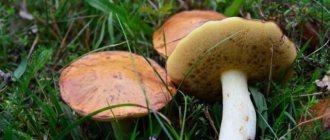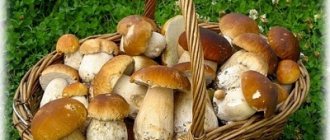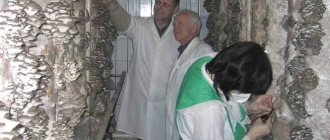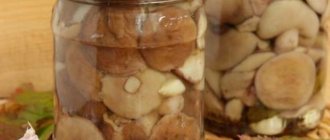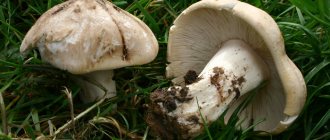Most mushrooms of the Ryadovka family are edible. But there are also poisonous specimens.
The habitat of these mushrooms is coniferous forests. But, as many mushroom pickers note, the mushroom is found near farms, in pastures, etc. That is, in those places where there is a lot of fertilizer. And there doesn’t have to be trees or sandy soil nearby.
Row mushrooms are marinated, fried, boiled, dried. Before use, first remove the film from the surface.
In this article we will tell you what edible row mushrooms there are, provide a description of each type and its photo.
Row red
This name is rarely used. More often, it is called pine honey fungus. This is a conditionally edible mushroom. They are collected only when they are young. Every day the fruit tastes more and more disgusting.
The pulp is lemon-colored and very dense. The taste is not perfect. There is some bitterness. Also, the fruit smells like some kind of rotten stump.
Application
After all the procedures for preparing the fruits have been carried out, they are allowed to be used in everyday life and for food. Poplar row is used in cooking and folk medicine.
Cooking
Poplar row, like other conditionally edible forest mushrooms, goes through several stages of processing:
- Soak in cold water for several days.
- Boil for at least 15 minutes in boiling water.
- Washing the fruiting bodies under running water.
Irina Selyutina (Biologist):
Before soaking, the poplar row needs to be treated. The difficulty here is to thoroughly clean them of forest debris and soil. In order for the cleaning to be of high quality, it is better to take a soft brush and use the tip of a knife to clean the plates. If this preliminary part is not done in good faith, then the rest of your work will not save the situation - the banks will begin to explode.
The container with mushrooms should be stored at a temperature of no more than +16°C. After this, they are pickled, salted or fried.
Mushroom caviar is also made from wild mushrooms. To prepare it, the boiled pulp (without legs) is crushed with a blender or using a meat grinder, stewed with onions, vegetables and spices.
They are prepared for the winter, deep frozen (boiled), defrosted immediately in soup or in a frying pan. Meaty caps go well with porridge, baked potatoes, and a side dish of vegetables.
In folk medicine
Decoctions from poplar row are not used as a medicine. Infusions of fruiting bodies are also not recommended for use without prior consultation with a doctor. Extracts are partially used for creams and ointments in cosmetology, but it is impossible to prepare them at home.
Gray row
The gray mushroom may initially seem poisonous. Especially when she is young, it seems that the mushroom is inedible. But this is just the first impression. In fact, it tastes better than yellow and red.
Young gray rowers have convex caps, which is why they slightly resemble toadstools. But as they grow older, the caps level out and become flat.
The pulp has a grayish tint, but fruits with yellowish “meat” are often found.
Beneficial features
Mushrooms contain beneficial microelements
The poplar row variety contains a lot of useful substances. Its pulp contains a lot of fiber, which cleanses the body. It also contains trace elements: magnesium, potassium, manganese, sodium. The presence of vitamin C was recorded.
The product is low-calorie (about 25 kcal per 100 g), therefore it is indicated for diets. In addition, due to the presence of fiber in these mushrooms, a person quickly becomes satisfied with them and does not feel hungry for a long time.
The row is crowded
The name itself suggests that this variety grows in heaps. This is one of the rare species whose legs stick together so tightly that sometimes it is simply impossible to separate them from each other. The sizes of the caps vary between 5-12 centimeters. Moreover, in one “family” there can be completely different fruits. Some with 12 cm hats, others with small 6 cm hats, etc.
The cap itself is smooth. The color is dirty brown. The older the fruit, the duller its shade. The crowded row is very tasty. Its flesh is elastic and has a delicate floury smell.
Description of the mushrooms
The Oryadovaceae/Tricholomaceae family is so named not for its “love” for geometrically correct structures, but for its crowded growth. In one place, mushroom pickers sometimes collect 1.5 buckets. Poplar row is no exception in this regard.
Its Latin name is Tricholoma populinum from the genus Tricholoma. When determining a poplar row from a photo and description, it is better to rely on Latin. In regions, the mushroom is called differently:
- floodplain;
- poplar;
- subtopolevik;
- poplar row;
- sandstone;
- sandpiper;
- spoilers;
- frosties.
These are the same type of poplar rows, and not different mushrooms. But other representatives of the Tricholomaceae family can also be called sandpipers and sandpipers. The fruiting bodies of tricholomas are often “hidden” underground. Hence such strange names.
Attention! Podtopolniks always grow and always grow near poplars.
But rowers, including poisonous varieties, can be found throughout coniferous and deciduous forests. The real underwater plant belongs to the group of conditionally edible ones.
What do flood mushrooms look like?
Often poplar rows look like small mounds of earth. Some fans even look for them using rubber shoes: a hard lump can be clearly felt under the thin sole. Medium-sized leg: 2-10 cm. Most often about 4 cm high. Diameter (2-4 cm) is almost the same along the entire length. Only at the mycelium itself the stalk barely noticeably thickens.
Comment! A variant with a thick stem, similar to a highly elongated drop, is possible.
Inside the leg is dense, without cavities, fleshy. The consistency is dry. The color is pinkish-brown (old) or pinkish-white (young). The surface can be smooth or fibrous. Covered with flocculent scales. When pressure is applied, brown spots remain on the stem.
The young topiary has a hemisphere-shaped cap. The edges are thin and curved inwards towards the stem. As it grows, the cap straightens, becomes fleshy and slightly curved. The skin is pinkish-brown. In rainy weather it becomes slippery. Cap diameter 6-12 cm.
The hymenophore of a young tortoiseshell is white; with age, the plates become pinkish-brown. The flesh is white, but under the skin of the cap it has a brownish color. At the break it turns brown. Opinions about the smell vary. Reference books usually indicate the pleasant aroma of fresh flour. But some mushroom pickers believe that the poplar row smells of soap. In fact, there is a high probability that poplar is confused with soap. The latter really smells like fruit soap.
Comment! Regarding the taste, opinions are the same: either mealy or soapy.
And the reason for the discrepancies, apparently, is again confusion.
Where do floodplains grow?
Distributed in southern Russia and Siberia. They are also found in Europe. They live in symbiosis with poplars, so this species can only be found in natural poplar groves and artificial windbreaks.
The peculiarity of the poplar row is that it grows in large groups and is not found in ordinary deciduous forests. It forms a symbiosis with poplars and prefers sandy soil. But due to the fact that the experience of picking mushrooms is usually passed on from generation to generation, confusion often arises with the names. This is how various “false floodplains” appear, but in the photo in this case you can usually see a different row. And it’s also good if this species is edible.
We must remember that this row of poplars is a companion of poplars. Other rows grow in mixed and coniferous forests. Often no less tasty, but not poplar.
When floodplains grow
The collection time for floodplains is mid-August - early October. For harvesting and preparing fresh mushrooms, flood mushrooms are collected young, before the cap has yet opened. The fruiting bodies at this age are hard and contain almost no worms.
Earthy row
At a young age it has a conical cap. Gradually it straightens and becomes almost flat, leaving only a small bulge in the central part. It feels like silk, but over time the surface becomes covered with coarser scales. The color is gray or gray-brown. The pulp is dense. It does not have a particularly pronounced odor. And there is almost no taste. In Russia, this type of rowing has not received much recognition. In Europe, on the contrary, it is considered a real delicacy.
A variety of floodplains
Strictly speaking, there are no varieties of floodplains. There are more than 2,500 species of the family Ordinaceae. Some of them are considered varieties of the same mushroom. The following rows can be taken for undertopolnik:
- crowded;
- gray;
- earthy;
- green;
- brown;
- leopard print
Since these species have a similar growth mechanism (almost underground), they are often mistaken for varieties of floodplains. The fact that the growing places, descriptions and photos of these mushrooms do not coincide with sandpipers is of little concern to anyone. At most, they will be called a false sandpiper/row.
Comment! Podtopolnik is also called the value mushroom.
Most likely for the appearance. But the valui has not the slightest relation to the ordinary ones: it is a family of Russula. The photo shows not one of the types of floodplains, but a valui. He's a bull. It is enough to cut off the fruiting body to understand the difference: the stem of the row is dense, while that of the valuu is hollow.
Green row
Popularly it received a simpler name - greenfinch. It received this name due to its unique color. Interestingly, even after cooking it remains the same green.
We recommend reading: “Chicken Mushrooms”
The mushroom is fleshy and dense. The young fruit has a flat-convex cap type. Over time it begins to level out. But, as with the purple-footed type, the cap begins to burst and eventually it either cracks or takes on a straight-twisted shape.
The color is close to olive. The fruit is slimy to the touch.
The peculiarity of this species is that it is almost never affected by worms. For example, the same lilac-legged rower very often suffers from these parasites.
All of the above mushrooms are absolutely edible. They are suitable for marinating, frying, boiling, and drying.
What false floodplains look like
Since in fact these are simply representatives of the same family of Tricholomaceae, edible and even more valuable mushrooms are often called false flood mushrooms. At the same time, “false sandpipers”, even in the photo, cannot be confused with poplar rows. In nature, this is almost impossible if you know which type of tree a particular type of tricholome is “attached” to.
Edible rows
Quite valuable mushrooms, which generally grow either under birch trees or in coniferous forests, are mistaken for false floodplains. The adjective “false” can scare an inexperienced mushroom picker away from several edible and tasty rows:
- gray;
- green/greenfinch;
- crowded;
- matsutake.
The latter is considered a delicacy in Japan and almost all of it has already been destroyed.
Gray rower (Tricholoma portentosum)
Other names:
- little mice;
- pine tree;
- serushka;
- the row is hatched.
It differs from poplar in the gray color of the cap and the type of trees necessary for the mycelium. Mycorrhiza forms with pine. Grows in coniferous and mixed forests. Like poplar, it loves sand. Can be found together with the greenfinch.
The fruiting seasons for mouse and poplar rows coincide in September-October. But in the south of Russia the gray lily grows right up to frost and is never found under poplars.
Comment! In Crimea, baby mice are considered very valuable mushrooms and are readily pickled for the winter.
A good video of a forest where there are no floodplains, but a lot of gray rows.
Green rower (Tricholoma equestre)
She's the same:
- greenfinch;
- jaundice;
- brilliant green;
- golden;
- lemon
Grows on sandy soils in coniferous forests. Mixed ones “like” less, but they also occur. Found one at a time or in small groups of 5-8 fruiting bodies. The fruiting season is from September until frost. A common mushroom in the Northern Hemisphere.
Crowded row (Lyophyllum decastes)
Does not apply to tricholomas. It is a member of the lillophyllum family. But some of the species of this family are also called rows in everyday life. Synonyms for the names group row and crowded lyophyllum.
Young poplar and group rows can be confused. They have similar shape and color. But lyophyllum is smaller in size. There is nothing wrong with the confusion, since both species are edible.
Matsutake (Tricholoma matsutake)
There are no synonyms. The name means "pine mushroom" in Japanese. Grows in symbiosis with coniferous trees. The main condition for the survival of this species is infertile soil. If the quality of the soil improves, there is a large amount of rotting organic residues, and the fungus dies.
Distributed in the northern regions of Eurasia and America. It is imported to Japan from Scandinavia and Finland.
Externally, matsutake is very similar to poplar row, but differs in smell and taste. Depending on the region, the aroma of the mushroom is either pine or cinnamon-like.
Comment! Unlike other tricholomaceae, matsutake is difficult to extract from the soil.
Inedible rows
Among the true rows of the genus Tricholoma there are relatively few of them. But the Tricholomov family also includes genera of talkers and honey fungus.
In the latter, the most famous is the false honey fungus. Among the talkers there are many poisonous species, but they differ from real rowers by their concave caps. It is difficult to confuse talkers with edible rows.
But among tricholomas there are poisonous species. The most similar to the poplar row is the spotted one. You still need to try to confuse the leopard mushroom with other types of mushrooms except fly agarics.
Spotted rower (Tricholoma pessundatum)
Second name: ruined. Slightly poisonous mushroom. If confused with edible rows, it can cause poisoning. It is dangerous because it is very similar to poplar. The cap is brown, the smell and taste are mealy, like that of the tortoiseshell.
What saves you from poisoning is that this mushroom also grows in forests with coniferous trees. It can only be found near poplars if pine, spruce and other similar trees grow nearby. Grows throughout Eurasia and North America. The fruiting season is from September.
Leopard leopard (Tricholoma pardinum)
She is tiger and poisonous. It is easy to confuse it with the serushka, but not with the subtopolevik. The hat of the poisonous row of different variants is gray. The leopard or tiger row is named for the characteristic pattern of the cap formed by the skin bursting during growth. The network of cracks resembles leopard spots or tiger stripes.
Grows in coniferous and beech forests, preferring calcareous soil. Rarely seen. Distributed on the Eurasian and North American continents. It is quite rare. Fruiting season is August-October.
Poisonous species and differences from edible ones
Ingestion of poisonous row plants is very dangerous for human health. These include the following types:
- spruce;
- white;
- toad;
- smelly;
- conical (pointed);
- brindle (leopard);
- spotted;
- scorched (tanned).
Edible species can only be confused with white, spotted and leopard rows. You can distinguish them like this:
- The white row is distinguished by its snow-white, sometimes yellowish color. The hat is spread out and velvety. The leg is cylindrical, slightly curved. Its surface repeats the color of the cap. You can recognize a mushroom by its pulp. It tends to change its color when in contact with air, so when broken it instantly turns pink. The pulp emits a sharp, unpleasant odor of radish.
White row - The cap of the spotted rower is spread out and slippery, with a small depression in the middle. It is painted light brown. Dark brown longitudinal stripes and spots of the same shade are clearly visible across the entire surface. The edges of the cap are slightly lighter. The leg is widened at the base. From below it repeats the color of the cap, and from above it is white.
Spotted rower - The leopard row is easily recognized by the characteristic leopard pattern on the surface of the cap: dark gray spots appear on a light gray background. The color fades a little along the edges. The hat has an open shape. The leg is white, thickened towards the bottom.
Leopard print row
Characteristic features of the species and collection rules
The genus includes species of all mushroom categories: from edible to poisonous. The rows are characterized by the following general features:
- a fleshy convex cap that acquires a flattened shape as it ages;
- cracked edges;
- presence of records;
- cylindrical leg;
- thick pulp;
- powdery odor in many species.
It is best to collect paths in the first half of autumn. It is not difficult to look for mushrooms, because they grow in a row and in large groups. You can distinguish edible and poisonous species by appearance, smell or reaction of the pulp to air.
Attention!
You cannot break the mycelium - the paths must be cut with a knife. A broken mushroom place leads to the death of an entire family.
Growing methods
The poplar row mushroom lends itself well to cultivation on the plot or in a prepared artificial mycelium. To grow wild mushrooms on your own site, you will need a substrate. It is prepared from a mixture of peat, soil and soil for plants. For 5 kg of substrate take:
- 100 g chalk;
- 1 liter of water;
- 50 g mycelium.
After the substrate is ready you need:
- mix the substrate and mycelium;
- place the substrate on the beds in a dark place (poplar rows are planted in conditions close to natural - under a tree);
- the area is regularly moistened, the temperature should not fall below +20°C;
- After 2-3 weeks, add a 5 cm layer of soil and repeat the procedure.
In another couple of weeks the first fruiting bodies will appear. After each collected batch, the soil layer is increased by an average of 5 cm. In autumn, when the temperature has dropped below +5°C, the bed is prepared for wintering. It is covered with a cloth and a 10 cm layer of straw or dry leaves is laid on top.
Poplars are also grown indoors. They create conditions that are as close to natural as possible. To do this, they create a lighting and ventilation system that is important for the life processes of fungi. Fruiting in this growing option will begin only after 4 months.
